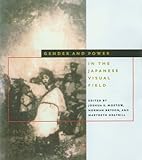Gender and Power in the Japanese Visual Field / ed. by Joshua S. Mostow, Maribeth Graybill, Norman Bryson.
Material type: TextPublisher: Honolulu : University of Hawaii Press, [2003]Copyright date: ©2003Description: 1 online resource (320 p.) : 108 illus., 8 in colorContent type:
TextPublisher: Honolulu : University of Hawaii Press, [2003]Copyright date: ©2003Description: 1 online resource (320 p.) : 108 illus., 8 in colorContent type: - 9780824825720
- 9780824841577
- NX180.F4 G44 2003
- online - DeGruyter
| Item type | Current library | Call number | URL | Status | Notes | Barcode | |
|---|---|---|---|---|---|---|---|
 eBook
eBook
|
Biblioteca "Angelicum" Pont. Univ. S.Tommaso d'Aquino Nuvola online | online - DeGruyter (Browse shelf(Opens below)) | Online access | Not for loan (Accesso limitato) | Accesso per gli utenti autorizzati / Access for authorized users | (dgr)9780824841577 |
Frontmatter -- Contents -- Illustrations -- Acknowledgments -- 1. Introduction -- 2. Gender in Japanese Art -- 3. The Image of Women in Battle Scenes: “Sexually” Imprinted Bodies -- 4. The Gender of Wakashu and the Grammar of Desire -- 5. Marketing Desire: Advertising and Sexuality in Edo Literature, Drama, and Art -- 6.Westernizing Bodies: Women, Art, and Power in Meiji Yāga -- 7. Icons of Femininity: Japanese National Painting and the Paradox of Modernity -- 8. Images of Women in National Art Exhibitions during the Korean Colonial Period -- 9. The Otherness of Women in the Avant-Garde Film Woman in the Dunes -- 10. Gender in Contemporary Japanese Art -- 11. Busty Battlin’ Babes: The Evolution of the Shōjo in 1990s Visual Culture -- Notes -- Bibliography -- Contributors -- Index
restricted access online access with authorization star
http://purl.org/coar/access_right/c_16ec
In this, the first collection in English of feminist-oriented research on Japanese art and visual culture, an international group of scholars examines representations of women in a wide range of visual work. The volume begins with Chino Kaori's now-classic essay "Gender in Japanese Art," which introduced feminist theory to Japanese art. This is followed by a closer look at a famous thirteenth-century battle scroll and the production of bijin (beautiful women) prints within the world of Edo-period advertising. A rare homoerotic picture-book is used to extrapolate the "grammar of desire" as represented in late seventeenth-century Edo. In the modern period, contributors consider the introduction to Meiji Japan of the Western nude and oil-painting and examine Nihonga (Japanese-style painting) and the role of one of its famous artists. The book then shifts its focus to an examination of paintings produced for the Japanese-sponsored annual salons held in colonial Korea. The postwar period comes under scrutiny in a study of the novel Woman in the Dunes and its film adaptation. The critical discourse that surrounded women artists of the late twentieth-century--the "Super Girls of Art"--is analyzed, followed by a consideration of gender ambiguity and cross-gender identification in contemporary anime and manga. Contributors: Grunhild Borggreen, Norman Bryson, Chino Kaori, Doris Croissant, Ikeda Shinobu, Kim Hye-shin, Chigusa Kimura-Steven, Joshua S. Mostow, Sharalyn Orbaugh, David Pollack.
Mode of access: Internet via World Wide Web.
In English.
Description based on online resource; title from PDF title page (publisher's Web site, viewed 27. Jan 2023)


